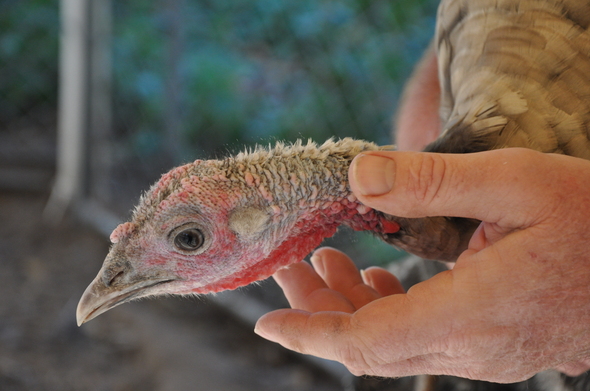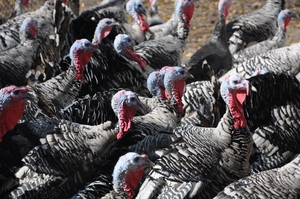Heritage turkey talk with John Harnois
In my Farm to Fork series, I visit local farms and share what I learn.

The head of a Narrangansett hen held by John Harnois. The bulbous bumps called caruncles are clearly evident.
Corinna Borden | Contributor
As I mentioned in my overview of Harnois Farms, John Harnois raises heirloom Narrangansett turkeys. He raises them, because, as he so succinctly put it, “You gotta eat ‘em to keep ‘em alive. If you don’t eat ‘em the genetics are going to be gone.” As signs abound everywhere for ordering Thanksgiving turkeys, a festival saluting their North American provenance, the time feels ripe to delve into the world of our gobbling domestic fowl.
In addition to the Narrangansetts, Harnois raises one of the two strains of the Broad Breasted Whites, the Nicholas strain. All Harnois poultry is raised in a free range, hormone-free, antibiotic-free environment.
According to the Heritage Turkey Foundation, 99.99 percent of what is sold in supermarkets is the Broad Breasted White variety. Harnois expressed concern about this market dominance.
“There are only a couple of strains out there [of the Broad Breasted]. That’s a problem. And if there are only two strains of these what is going to happen when something affects them?”

Narrangansett toms have snoods on top of their beaks that can range in color from blue to red, depending on their mood.
Corinna Borden | Contributor
If something happens, consumers will have a choice of eating beans and rice or paying three times as much for a turkey.
Broad Breasted Whites are cheaper to raise than the eight breeds of heritage turkey listed on the American Poultry Association’s turkey Standard of Perfection for recognized breeds (Slate, White Holland, Bronze and Narrangansett have been on the list since 1874). Bred for a fast turnaround on your initial investment of around $3.50 per poult, the birds have white feathers (which means if the developing pin feathers release pigment when plucked, the skin is not stained) and grow to maturity in around 20 weeks.
Raising Narrangansetts to keep alive the diversity of the turkey stock is, “just expensive all the way around,” shared Harnois. “Instead of having them for four months you have them for eight months, and they cost four times as much for a one day old poult. They cost the same to get them processed. They only weight between six and 16 pounds, and these guys [the Broad Breasted Whites] weight between 16 and 24 pounds. And their feed to muscle mass conversion ratio is very low. They are very inefficient to raise.”
Inefficient they may be, but it is clear that Harnois enjoys every moment of his time with his turkeys. Cradling one against his body, he strokes the head as he describes the anatomy of the bird.
A practiced yodeling gobble from Harnois elicited a chorus of gobbling from the Broad Breasted Whites in return. The Narrangansetts then responded to the Whites, for a call and response of back and forth calls between the birds.
Proponents of the “eat ‘em to keep ‘em alive” camp extol the flavor of the heritage breeds, especially the dark meat. Harnois and Morgan & York sell their heritage turkeys for $10 per pound — and are sold out. There is rapidly diminishing availability through the Heritage Foods website (www.heritagefoodsusa.com). Whole Foods is not selling heritage breeds this year because there was not enough demand last year.
John Harnois can be reached at 734-645-0300 or harnoishappyhens@gmail.com.
Corinna wrote a book about many things, works with the Westside Farmers Market, and spoils her backyard chickens.

